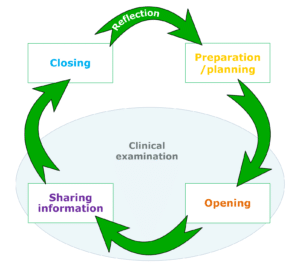
The VNCCM graphic outline
Publication Of The First Client Communication Guide For Veterinary Nurses
Why the VNCCM?
Veterinary nurses communicate with clients daily, in a wide variety of situations – and recent research demonstrates that the consulting role of the veterinary nurse is expanding; yet until now no consulting model or framework for veterinary nurses existed.
Veterinary nurses have a unique role in their interactions with clients. Whilst sharing a high level of technical, detailed and often difficult information with and from clients; they also have a skilled role in supporting and guiding clients; in helping them understand their pet’s condition, talking through concerns and fears, understanding the unique context of each pet-client relationship; which takes skill in building trusting relationships. Nurses become the practice professional that clients will often turn to talk things through or to gain help, when they maybe wouldn’t feel comfortable approaching the veterinary surgeon.
How was it done?
When attending a pre Vet Ed conference workshop, veterinary nurse Jill Macdonald had a conversation (over lunch of course) with colleague and workshop leader Carol Gray; and the idea for developing a veterinary nurse-specific consultation guide was born.
The research project, led by Jill, involved use of the Delphi technique to gain the input of a team of panellists with a range of expertise and experience across professions, and outlines the key components of nurse-client communication and the skills needed to achieve these components. The Veterinary Nurse-Client Communication Matrix (VNCCM) provides the first ever tool for teaching and for reference within practice that is specifically for veterinary nurses, and with their unique role and values at the forefront.
Additional concepts included
The VNCCM includes several additional areas of consideration: shared decision-making, informed consent, motivational interviewing and reflective practice.
The VNCCM graphic outline[/caption]
As Jill said, ‘it became clear during the early stages of the research that the work would have a strong focus on how to effectively build relationships with our clients through empathy, understanding and respect; and how important that relationship is in doing the very best we can in supporting clients and their pets.’
‘The concept of shared decision-making has been adopted by human healthcare for some time, and whilst known in the veterinary profession, we wanted to really hone in on why it is so important, and the things we can do to make it happen. It is only through including clients in the decision-making process, whether that be a simple treatment plan or end-of-life decisions, that we can achieve the best outcomes.’
‘Self-care and wellbeing was also a strong theme, and our section on reflective practice aims to help nurses to use reflection to assimilate and reconcile a difficult situation they have encountered, and also to learn from things that went well and how that learning can be useful in the future.’
‘Motivational interviewing has an extremely important place in many of the situations that nurses manage – in helping them to help the client to find their own motivations – whether that be for weight loss, keeping up to date with parasitic treatment, or adhering to a treatment regime.’
Jill has been a veterinary nurse for over 20 years, having worked in small animal primary care practice, at the University of Liverpool Veterinary School in professional and communication skills teaching, in managing ONCORE ePD, and in addition, in her current role as VN Futures project coordinator for the RCVS.
‘I am passionate about advancing the role of the veterinary nurse and completing this work has meant an incredible amount to me in playing a small part in that. Veterinary nurses have a phenomenal role in client communication and support, and I hope that the VNCCM provides some guidance on helping nurses to perform their role as effectively as they can, and from that, in achieving the outcomes for their patients that they always strive for.’
You can access the open source paper in Med Ed Publish (published May 2021) by following this link, and reviews are welcome.
The paper was authored by project lead Jill Macdonald, veterinary educator and researcher Dr Carol Gray, and Dr Iain Robbé. The next stages of the work will be to perform an evaluation phase for the matrix, and to publish the content online so that it can be easily accessed by educators, student veterinary nurses and practising veterinary nurses.
If you would like to know more about the VNCCM, you can contact Jill directly on [email protected].
References
Institute for Employment Studies. (2019) The 2019 Survey of the Veterinary Nursing Profession: a report for the Royal College of Veterinary Surgeons. Available at: https://www.rcvs.org.uk/news-and-views/publications/the-2019-survey-of-the-veterinary-nursing-profession/ (Accessed: 4 December 2020).
Macdonald, J., Gray, C., Robbé, I. (2021) 'The Development of a Veterinary Nurse-Client Communication Matrix', MedEdPublish, 10, [1], 144, https://doi.org/10.15694/mep.2021.000144.1
More from ONCORE ePD
- WE MUST CONSIDER DOGS TOO, WHEN WE IMPLEMENT LOW STRESS HANDLING
- ONCORE teams up with Jenny Moffett to transform practice outlook on well-being
- Vicky Ford-Fennah is new tutor for ONCORE
- New Course To Help Vets With The Medical Options For Cancer Patients
- Considering reviewing your practice infection control protocols?

 3 years ago
3 years ago  824 views
824 views
